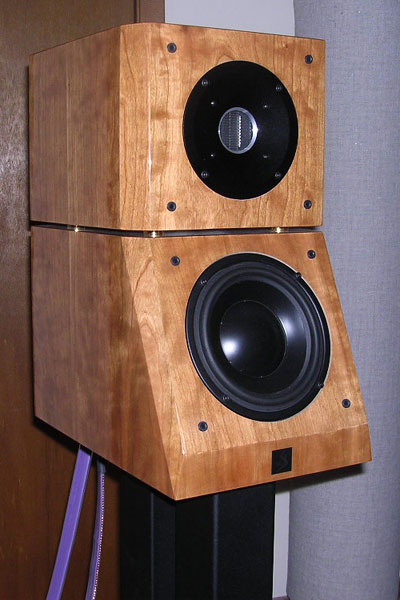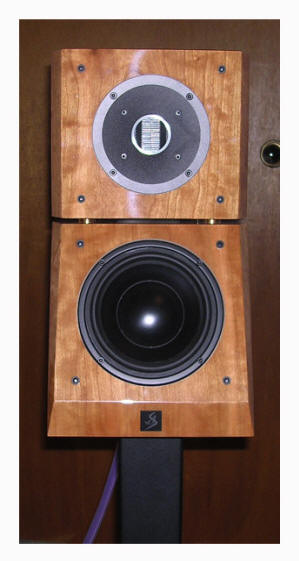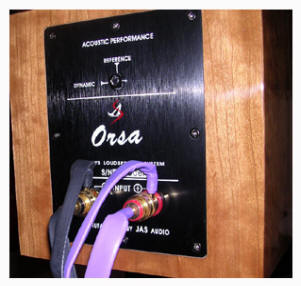You are reading the older HTML site
Positive Feedback
ISSUE
20
july/august
jas audio
Orsa loudspeakers
as reviewed by John Acton

|
JOHN ACTON'S SYSTEM
LOUDSPEAKERS
ELECTRONICS
SOURCES
CABLES
ACCESSORIES
|
Until recently, the phrase "Chinese high-end audio" would have been considered an oxymoron by many Western audiophiles, but companies like Cayin, Usher, Quad, Shanling, and Consonance are changing this perception. Their products have been consistently lauded by reviewers and listeners for their performance and value. Western companies, including Mobile Fidelity, Von Schweikert, Prima Luna, and Musical Fidelity have also started manufacturing in China. The cost efficiency and economy of scale cannot be ignored when marketing to a price point.
JAS Audio was founded in Hong Kong in 2002 with a vision of providing world-class audio components at an unprecedented price/performance ratio. The company has aligned with GINI Systems to bring a line of loudspeakers and tube electronics to the U.S. market. GINI Systems premiered the JAS Audio products at the HE 2005 show in New York. I was impressed with the sound of their setup, especially their entry-level two-way Orsa monitors, so I soon found myself working with Alfie Lew of GINI to secure review samples.
According to Lew, much expense and rigor went into the design of the Orsas. Drivers and crossover components were chosen only after exhaustive evaluation. Software modeling and anechoic chambers were utilized, and the final products were voiced and approved in audiophile listening sessions. The chief designers are from Hong Kong and China, and "well-known" American designers were consulted.
The Orsas were extremely well packed, and shipped separately in large, sturdy boxes. The review samples were finished in a grain-matched natural cherry veneer and were simply stunning. Rosewood and piano black are also available, and additional finishes are forthcoming. The construction of the Orsas is unique in my experience. Ostensibly a chunky stand-mount speaker, the Orsa is actually comprised of two separate cabinets, one containing the woofer and the other the tweeter. The cabinets are very impressive for the price—heavy and sturdy, with beveled edges to enhance appearance and reduce diffraction. A half-inch space separates the two cabinets, with a bass reflex port located between the two. The port radiates in a 360-degree pattern to lend a sense of spaciousness to the sound. Peering between the cabinets, I could discern the connecting wire running from the crossover in the bottom cabinet to the tweeter in the top cabinet, as well as the wool material used to damp cabinet resonances. The front of the bottom cabinet is angled back, again to enhance aesthetics and perhaps to provide time alignment of the drivers. The woofer actually winds up being considerably farther forward than the tweeter.
 The drivers are of very high quality
considering the price of the speaker. A 6-inch Morel DPC woofer/midrange
driver is mated to a revolutionary LCY twin-ribbon tweeter. The
crossover point is 2.4kHz. with a second-order slope for the woofer and
a modified first-order slope for the tweeter. The crossover contains
high-quality parts and an unusual key-operated switch on the back panel
to choose between "Reference" and "Dynamic" modes of operation. No
mention is made in the manual of the sonic differences between the two
modes of operation, but a quick e-mail to Alfie Lew cleared up any
confusion. The Reference setting is the standard setting, while the
Dynamic setting provides a subtle lowering of the impedance in the
critical 2kHz to 3.5kHz range to improve signal-to-noise performance and
provide a more forward, more dynamic presentation. Heavy-gauge silver
wire is used internally, and extremely heavy-duty binding posts attached
directly to the plate housing the crossover will accept any gauge of
wire and manner of speaker wire termination you can throw at ‘em.
The drivers are of very high quality
considering the price of the speaker. A 6-inch Morel DPC woofer/midrange
driver is mated to a revolutionary LCY twin-ribbon tweeter. The
crossover point is 2.4kHz. with a second-order slope for the woofer and
a modified first-order slope for the tweeter. The crossover contains
high-quality parts and an unusual key-operated switch on the back panel
to choose between "Reference" and "Dynamic" modes of operation. No
mention is made in the manual of the sonic differences between the two
modes of operation, but a quick e-mail to Alfie Lew cleared up any
confusion. The Reference setting is the standard setting, while the
Dynamic setting provides a subtle lowering of the impedance in the
critical 2kHz to 3.5kHz range to improve signal-to-noise performance and
provide a more forward, more dynamic presentation. Heavy-gauge silver
wire is used internally, and extremely heavy-duty binding posts attached
directly to the plate housing the crossover will accept any gauge of
wire and manner of speaker wire termination you can throw at ‘em.
The user manual is well written in English and is fairly typical of the breed. Recommendations regarding break-in (up to 200 hours) and suitable stands and decoupling (Blu-Tack is preferred) are provided, but no mention of speaker placement is made. Included with the manual are the warranty terms and a registration card. The warranty covers the speakers for a period of two years, which surprised me. Considering the high quality of the speakers and the stated goals of the company to compete with the big-name Western high-end firms, such a short warranty period is not exactly confidence inspiring. If JAS Audio and Gini Systems wish to establish a long-running dynasty of products, they need to support their products commensurately.
The Orsas proved to be relatively unfussy about placement. They sounded decent no matter where I plunked them down, although, as with any high-end speakers, exhaustive experimentation reaped rewards in sound quality. I settled on placing them about 3.5 feet from the back wall, 6.5 feet apart, and 7 feet from my listening position, all measurements taken from the tweeters. I employed a slight toe-in, which provided for the best tonal balance and compromise between soundstage width and image focus. I tried the Orsas on both 23-inch stands as well as my usual 28-inch stands. The taller stands raised the tweeters to just above my ears, which served to improve soundstage height and driver integration. The Orsa tweeters were the first ribbons I have heard that are not limited in terms of vertical dispersion. Even if I listened while standing, treble response did not drop off any more than would be expected from a typical 1-inch dome driver. The Orsas sounded good right out of the box, but I gave them the recommended 200 hours of playing time before critical listening. Though the speakers were musical from the start, they loosened up as they broke in, and exhibited greater dynamic ease and smoother response as the hours racked up.
The Orsas sounded quite engaging at the HE2005 show, so I wasn't expecting any unpleasant surprises in my listening room, and didn't get any. The Orsas sounded exciting, with a crystal-clear, pellucid, and lively presentation that resolved the finest musical details. The speakers had excellent jump factor, and while they didn't require lots of power or high levels to sing, they also played extremely loudly when required, with no signs of compression. Genesis' Selling England by the Pound (Atlantic 82675) was a revelation over the Orsas. Peter Gabriel's voice at the beginning of "Dancing Out With the Moonlit Knight" was palpable and natural, and his solo flute playing in the middle of "Firth of Fifth" gave me goose bumps. The micro-details in this recording had nowhere to hide, but the microscope-like insights did not cut both ways—the recording's slight emphasis of vocal sibilance was not covered up by the superb ribbon tweeters, but was rendered so cleanly that any objectionable prominence was ameliorated.
The soundstage was spacious but slightly diffuse, and was more reminiscent of the Magnepan speakers I used to own than my current ProAc Tablette Reference 8 Signatures. The Orsas portrayed large, well-demarcated images, but the images did not possess the focus that is the purview of precision mini-monitors. Bass was tight and rhythmic rather than warm and rounded, in my opinion a good choice on the part of the designers as it helped to ensure that the low frequencies could keep up with the litheness and cleanliness of the ribbon tweeter.
Dynamics and pacing were the Orsas' strong suits. On "Runes," from Redshift's Oblivion (Distant Sun DS05), they did a consummate job of rendering the undulating dynamic waves of tension that contribute to the song's sense of menace. Likewise, the jaunty and ebullient nature of songs like "Soul Lifter" and "Turn it On" from Lindsay Buckingham's Out of the Cradle (Reprise 26182) were well portrayed, with Buckingham's vocals and guitars leaping infectiously out of the speakers into my room, making it impossible for me not to smile and nod my head along with the tunes.
Lest you infer that the Orsas are one-trick ponies, I'm happy to report that they did well with less raucous fare. Simon and Garfunkel's Parsley, Sage, Rosemary and Thyme (Columbia/Legacy CK 66001) has long been one of my favorite recordings. I was impressed at the sheer presence of Paul Simon's vocals on songs like "Cloudy" and "The 59th Street Bridge Song (Feeling Groovy)." Vocals were always well handled by the Orsas. From Jay Ferguson of Spirit to Kerry Minnear of Gentle Giant to Lisa Gerrard of Dead Can Dance, voices were rendered with a tactility and sense of detail that was often shiver-inducing.
You may have noticed that I haven't singled out the ribbon tweeters, and in fact I found that the ribbons were superb at doing what tweeters should do—presenting high-frequency information cleanly and accurately without calling attention to themselves. There was plenty of air and extension without a trace of grain. Just as impressive, however, was the seamless manner in which the ribbons were mated to the dynamic woofers. I heard no crossover-related anomalies or sluggishness that would indicate that the high- and low-frequency drivers weren't keeping up their ends of the bargain.
As you can probably tell, I really liked the Orsas. Still, no speakers are perfect, and the Orsas did have a few drawbacks. First, though the problem was minor and occurred rarely, the Orsas could sound a little congested during complex musical passages, making it difficult to discern single musical threads from the larger whole. Second, the height of the soundstage was slightly foreshortened compared to other speakers I've heard. Again, this was minor and did not detract from my enjoyment of the music. I also detected a slight forwardness in the upper midrange and presence regions. On most recordings, this served only to subtly enhance detail. On more forward-sounding recordings, I sometimes heard too much of a good thing, though this may have been due to the fact that the Orsas were coupled with my Audio Zone Amp-1, which has a slightly forward character. The effect was noticeable on recordings like the Moody Blues' To Our Children's Children's Children (Threshold 42284 4770). Voices and other midrange instruments were pushed forward in the mix, resulting in a slightly shouty presentation that took away from my enjoyment. Again, this forwardness might have been mitigated by the substitution of a warmer-sounding amplifier.
 What about that Reference/Dynamic crossover
switch? Its effects were very subtle, but the Dynamic setting gave even
moiré emphasis to the upper midrange, which added additional jump factor
at the expense of tonal neutrality. Most of the time, I chose the
standard Reference setting.
What about that Reference/Dynamic crossover
switch? Its effects were very subtle, but the Dynamic setting gave even
moiré emphasis to the upper midrange, which added additional jump factor
at the expense of tonal neutrality. Most of the time, I chose the
standard Reference setting.
I spent a lot of time comparing the Orsas to my ProAc Tablette Reference 8 Signatures. The Tablettes had greater coherence, and disappeared into the soundstage more effectively than the larger Orsas. The Tablettes had better focus, and exhibited laser-like precision compared to the more enveloping diffuseness of the Orsas. Nevertheless, the Orsas had greater image density and more palpability. Their midrange was a little more forward, making vocalists sound larger and more immediate. The Tablettes were more relaxed, with vocalists and other midrange instruments placed farther back in the soundstage. They had a lit-up, romantic warmth, while the Orsas were more analytical. The Orsas had almost no boxy sound that I could discern. With their lack of cabinet coloration, they sounded more like panel speakers than dynamic cone-and-box speakers, whereas with the Tablettes, I could hear a slight hint of the boxes imposing themselves on the sound. The Orsas had more air in the treble, while the Tablettes sounded slightly sweeter. The Orsas, not surprisingly, had better bass extension, with a surprising pace and speed. The Morel woofers possessed a level of celerity that proved to be a near-match for the smaller Tablette drivers. The Tablettes were ultimately more involving, though only slightly, with an organic flow and wholeness that the Orsas, with their better resolution, could not match. The Orsas let me hear into recordings more convincingly than the Tablettes, but the Tablettes possessed that ineffable ability to bring the music and me together.
China has rapidly shown itself capable of competing with European, North American, and Japanese high-end audio manufacturers. With the Orsas, JAS Audio has achieved a milestone in Chinese loudspeaker design. Top-notch components and cabinetwork have been married with competent design to produce over-achieving loudspeakers. Their fast and airy treble, open and punchy midrange, and taut, rhythmic bass combined with a spacious soundstage and realistic dynamics to create detailed and insightful music makers. As with any component, synergy is important, and the Orsas are best mated with amps that are not lean or forward-sounding. The Orsas are remarkable performers, especially for their price. They do many things right and few things wrong, making it easy for me to recommend them to anyone shopping for speakers in the under-$3000 range. John Acton
-
Description: 2 way vented, twin cabinet, 2 units
-
Frequency Response: 45Hz – 60kHz
-
Impedance: 8Ω
-
Nominal Power: 150W
-
Sensitivity: 88dB
-
Drive Units: 5" twin ribbon tweeter, 6" DPC cone midrange/bass
-
Crossover Frequency: 2400Hz
-
Dimensions (cm): W 23 x H 42 x D 34
-
Weight: 11kg/pc
Orsa
Retail: $2290 a pair
GINI Systems
web address: www.gini.com
